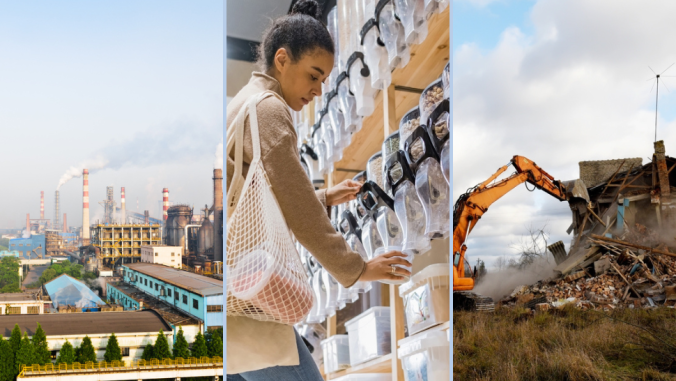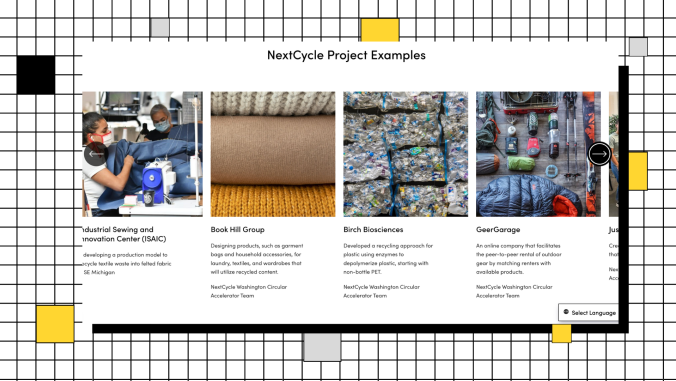How Zest Labs is tracking produce to reduce waste
The company uses sensors to provide data about a product's shelf life.

Tractor with production line for automatic lettuce harvesting.
Back in 2015, the United Nations called on the world to cut its food waste in half by 2030. Four years later, during this year’s Climate Week, a significant number of organizations are still pledging to reduce their food waste.
Each year, the United States wastes between 125 and 160 billion pounds — up to 40 percent — of its food, according to nonprofit NRDC’s 2017 report (PDF). ReFED, leading food waste think tank, estimates that improving inventory management could divert 59,000 tons of food waste per year in the United States alone. Produce has the highest waste rates of any food, according to the United Nations Food and Agriculture Organization, in part because it faces higher perishability and U.S. farmers typically grow food in open fields in lieu of using greenhouses, which some scientists and farmers say is better for the environment (because it uses less water) and the produce itself (because the fruits and vegetables stay fresh longer).
"[Fresh produce] is typically some of the healthiest food we can eat, because it's high in nutritional value, vitamins and minerals. But it's also more difficult to handle. And that handling becomes critical in preserving the shelf life or how long the product lasts," said Peter Mehring, CEO of Zest Labs, a post-harvest agtech company.
To address the food waste issue, Zest Labs has zeroed in on one small but critical link of the supply chain to understand why produce might spoil while in transit to retailers, or shortly after a consumer buys it, and find ways to prevent that from happening.The United States wastes between 125 and 160 billion pounds — or up to 40 percent — of its food each year.
Mehring says his company’s "Zest Fresh technology" helps companies across food supply chains locate problem areas by tracking the lifespan of fresh produce from the farm to the grocery store. Sensors, which gather information about harvest quality, the product's aging rates, field conditions and microclimate, are attached to pallets and each given a "Zest Intelligent Pallet Routing Code," or what the company refers to as ZIPR Code (pronounced "zipper"), a real-time metric of the product’s remaining shelf life. That allows their clients at the beginning of the supply chain — farmers and distributors — to make informed decisions about where the food will be shipped.
I recently spoke by phone with Mehring, as both of our Bay Area cities faced power outages. Following is an excerpt from that conversation, edited for clarity and length.
Deonna Anderson: How is Zest Labs working to address food waste?
Peter Mehring: We wanted to look at a way to proactively avoid waste, versus focusing on repurposing waste for recycling or reuse or food banks, which are all great solutions, but they don't address the big impact of not having enough food for a growing population, or having the environmental impact of food in our waste system creating significant greenhouse gases, and also the economic burden of food waste.
We thought if we could find a way to be more preventative around food waste, expecting that there'll always be some waste, that we could better address all those aspects of the issue — environmental, economic and feeding a growing population. We look at why food is wasted. We really focus on fresh food, to be clear, not processed or preserved food, but on fresh food that has a limited shelf life, anywhere under two or three months.
Anderson: How does your Zest Fresh technology work to address these issues?

Iceberg lettuce, hearts of romaine or some standard head lettuce typically is supposed to last about 18 days from harvest. That's what growers will indicate with a best used by date. But if you knew some of the product was harvested under non-ideal conditions, and it was only going to last 14 days, you could then ship that to a closer location that maybe is only a day away, instead of shipping it to a location that's five or six days away, thereby effectively saving four days — the same four days that you know it's not going to last as long. So you're making an informed decision with data.
Anderson: A lot of what I’ve read about Zest Fresh is for produce, and I'm curious about if the service you have for protein works any differently.
Mehring: It essentially works the [same way]. The science behind the solution is different, because what causes protein, seafood and meats to age is different than what causes produce to age. But the result and how our software works is the same, because we translate all of those science-based issues and items and sensor readings into the same action for the store managers, distributors, suppliers and back into shelf life.
We've highlighted produce because since protein is of higher value, there's been more focus in the supply chain to reduce waste already, and the actual waste of protein by rate is about half of that of produce. But by dollar value, it's actually higher.
So it's a mixed challenge, in that we could argue to the retailer there's more money to save, but typically, they have lower volume and lower waste, so they'd like to address their bigger volume waste issue first, which is produce. We've led with produce because we've had more interest in that from retailers and restaurants, but we do have the similar solution for seafoods, meats and other proteins.
Anderson: Why is it important to target the segment of the supply chain that Zest Labs is currently focused on?
Mehring: Roughly half of all food waste happens pre-consumer, depending on the product type, and the other half happens as a consumer, where we buy it. Maybe we buy too much, or maybe it just goes bad early, or maybe we change our minds and end up throwing it out. But half of it happens actually before the consumer even has a say. And now we found that very interesting, because if you say food waste is 30 to 40 percent of the fresh food harvested, that means anywhere from 16 to 20 percent is being thrown out before even a consumer has a say in that. And that also means that 16 to 20 percent has a direct economic impact to someone handling the product before they get to sell it, whether it's a grower, the distributor, the retailer, the restaurant.
Someone's losing money, and should have a motivation directly to reduce the waste because they're in business to make money. If we could help them not lose as much money, that's just as good as making it.
If you say food waste is 30 to 40 percent of the fresh food harvested, that means anywhere from 16 to 20 percent is being thrown out before even a consumer has a say in that.
Anderson: With that in mind, do you see your customer as the supplier, grocer and the restaurant? Who exactly would you say is Zest Labs' customer?
Mehring: We actually break it into two segments, and we have slightly different offerings and products. For the growers or suppliers, we help them gain visibility into their own farming operations of how well they're doing, not only to preserve the shelf life, but how many pallets of food do they produce a day? Where do they spend their time? All of that is interesting information to them that is not interesting to the restaurant or the retailer.
Our other segment of customers are the people who are providing the food to consumers — we group restaurants and food service companies and retailers altogether. They do have slightly different businesses, but basically, we help ensure that the foods they're buying from the supplier have the delivered shelf life that they expect, so they get fewer surprises, and can honor the implied guarantee they're getting to their consumers. And it's different to retailer to restaurant to food service, but we accommodate that in our software.
Anderson: During this year's Climate Week, some companies pledged to do more to curb or eliminate their food waste. I'm curious if there are things that you feel like companies — it could be restaurants and retailers, or distributors — can do more of, in addition to potentially using Zest Fresh to curb their waste?
Mehring: I think a lot of it is education. Trying to offer all types of food year-round is part of the reason there's waste also. We've gotten a little bit, pardon the pun, but we've become spoiled as consumers to expect to have fresh strawberries year-round. And sometimes, they have to ship them from South America to come to us, and obviously, that's a challenge.
And sure, they cost a little more, but the expectation is that every store wants to feel like they have to have strawberries to attract consumers, when that expectation just leads to some waste. I'm using one example, but there are a lot of examples of different types of products. But when [companies] make commitments to reduce waste, some of it is they can do more to repurpose and recover waste with local community food banks and charities.
[Grocers] do a very good job with shelf-stable foods, finding homes for them when they go past the best used-by date. But fresh food is a different challenge, just because it changes so quickly, that that's an opportunity to help better connect food banks with fresh produce. Plus, it has more nutritional value as well.
I think the other one is having a way to communicate better to consumers. We know one company that made smart containers [to store produce] that would tell you when you bought it and how long it would last in your refrigerator. That's a way to help the consumer reduce waste so it doesn’t get stuck in the back of your refrigerator. And the software can suggest recipes that use up the food you have before it goes bad — because, again, half the waste is on the consumer side — and could help consumers better manage what they already have before they go out and buy more fresh food.
Anderson: It's been almost three years since Zest Labs introduced the ZIPR Code. I’m curious about what would success look like for ZIPR and Zest Labs and all the work that you are doing.Our goal from the beginning has been to proactively prevent waste, and if we could do that in a measurable success rate across the country, that would be success for us.
Mehring: Success is actually showing across a good part of the U.S. [There’s] a measurable reduction in food waste. Our goal from the beginning has been to proactively prevent waste, and if we can show a measurable success rate across the country, that would be success for us.
We're working with organizations on how to obviously deliver that as a business, for retailers, but also how to measure that success, and let companies who make zero waste proclamations and challenges take credit for what they're doing to show that they're on their way to reducing waste, with this as one of the tools they're using.
Anderson: Are there any points we didn't get to but that you think are important for readers to know about Zest Labs, Zest Fresh or food waste more generally?
Mehring: Food waste reduction seems to get attention at a number of conferences, like the VERGE 19 Conference coming up, but it doesn't have a consistent presence in the consumers' mind as something they use to discern what they should and shouldn't buy, or who they should or shouldn't buy it from.
It's getting better, but I think it still has a long way to go before this becomes a real solved problem. Consumers care first about having online ordering or home delivery or other priorities, and food waste gets reduced mindshare. And that's disappointing. This has many aspects that impact our economy, our environment, and frankly, the quality of food we enjoy at home. I think with education, this would become a bigger issue with consumers.
Anderson: That reminds me that there is no silver bullet solution to any of our problems. We have to do a bunch of stuff to actually tackle it.
Mehring: That's right. And I think any time you want to tackle a big problem that has a lot of people involved in solving it, education really needs to be the first step, because people need to know what they can do to help reduce the problem.
Learn more about how organizations are using technology to tackle food waste at VERGE 19 in October in Oakland, California.





